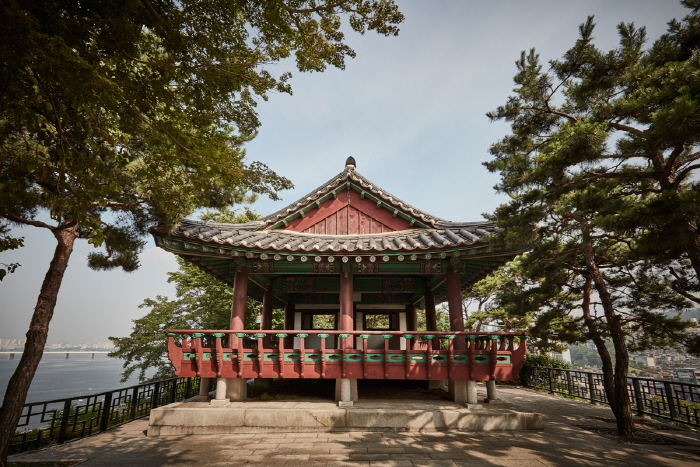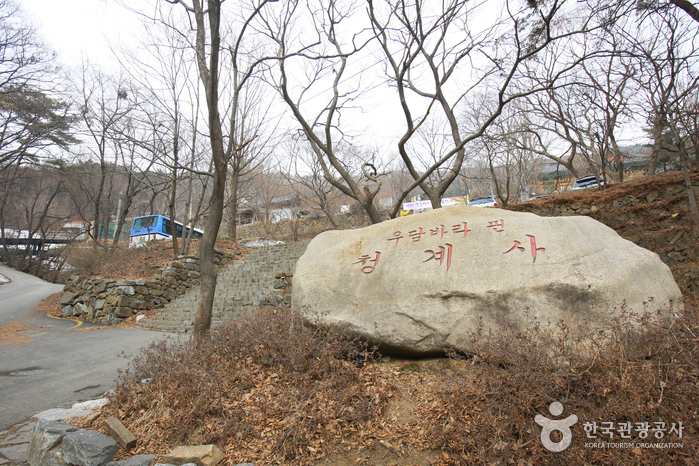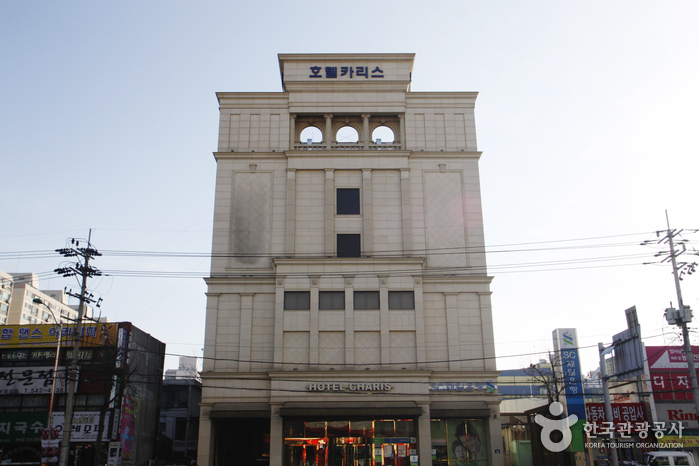E-Mart - Gyeyang Branch [Tax Refund Shop] (이마트 계양)
18.4Km 2024-04-22
785, Bongo-daero, Gyeyang-gu, Incheon
-
Hangang Paradise (한강파라다이스)
18.4Km 2024-03-25
252 Yeouidong-ro, Yeongdeungpo-gu, Seoul
+82-2-447-3333
Hangang Paradise is a renowned Italian restaurant nestled in Yeouido Hangang Park. It offers a diverse menu featuring items such as steak, pizza, dongaseu (pork cutlet), and bulgogi deopbap (stir-fried bulgogi served with rice), with the tenderloin steak being the standout dish. Guests can savor their meals while enjoying the picturesque views of the Hangang River. Additionally, Hangang Paradise operates a quay for duck boats, adding to its allure as a favored destination for those visiting the Hangang River area.
Hyosajeong Pavilion (효사정)
18.4Km 2025-01-13
55, Hyeonchung-ro, Dongjak-gu, Seoul
+82-2-820-9848
Hyosajeong Pavilion is where Nohan, the second vice premier of the Joseon dynasty during King Sejong and King Sejo’s reign, stayed. After he lost his mother, he built the pavilion to mourn at her grave while still being able to see his father’s grave in Gaeseong to the North. His brother-in-law, then Minister of the Interior, Gang Sa-deok named the pavilion “Hyosajeong,” which means pavilion of filial piety.
In order to find the original location of the pavilion, poems by Jeong Inji and Seo Geojeong and an old map of Korea were referenced, but the pavilion was not found because the surrounding landscape had changed too much. As a result, a location was selected and the pavilion was reconstructed at its current location. The house is 3 kan* in the front and 2 kan* on the side. The roof is a hip-and-gable roof. The pavilion has one room with under floor heating and a railing around the pavilion
(* kan: a traditional measurement that corresponds to the space between two columns)
Mayfield Hotel [Tax Refund Shop] (메이필드관광호텔)
18.5Km 2024-04-16
94, Banghwa-daero, Gangseo-gu, Seoul
-
Gyeonggi Cheonggyesa Temple (청계사(경기))
18.5Km 2021-11-23
475, Cheonggye-ro, Uiwang-si, Gyeonggi-do
+82-31-345-2533
Cheonggyesa Temple is a Buddhist temple near Baegunhosu Lake that became well-known as the site of udumbara flower, a rarity that blooms on Buddhist statues. Built during the Silla Kingdom, the temple offers many sights, including the Cheonggyesa Temple Monument, Geungnakjeon Hall, the bell tower, Samseonggak Shrine, Ksitigarbha Hall, and Gamnoji Pond. Among the many things to see, visitors should not miss a glimpse of the Bronze Bell of Cheonggyesa Temple and the Wood Printing Block in Cheonggyesa Temple. Created in the 27th year of the reign of King Sukjong (1701) of the Joseon dynasty, the Bronze Bell has been designated as a national treasure, and is adorned with elaborate patterns.
Cancelled: Seoul National Cemetery Spring Blossom Event (현충원, 호국의 봄을 열다)
18.5Km 2022-05-13
210, Hyeonchung-ro, Dongjak-gu, Seoul
• 1330 Travel Hotline: +82-2-1330 (Korean, English, Japanese, Chinese) • For more info: +82-2-815-3625
Every year, Seoul National Cemetery hosts an event when the weeping cherry blossoms within the cemetery are in full bloom. The weeping cherry blossoms symbolize patriotism and have a particularly pink appearance. The weeping cherry blossoms offer a fascinating sight with their branches hanging down, resembling a waterfall of flowers. The hanging branches may also seem to be bowing down to pay respect to the brave soldiers and martyrs who fought for the country.
Himart - Jeongjasageori Branch [Tax Refund Shop] (하이마트 정자사거리)
18.5Km 2024-04-19
286, Suseong-ro, Jangan-gu, Suwon-si, Gyeonggi-do
-
E-Land Cruise (Hangang River Ferry Cruise) (이랜드크루즈 (한강유람선))
18.6Km 2024-10-31
(Nodeulnaru Park), 290, Yeouidong-ro, Yeongdeungpo-gu, Seoul
+82-2-6291-6900
The E-Land Cruise cuts across the Hangang River along the east-west axis. It connects two terminals, one in Yeouido and the other in Jamsil. The company offers a number of different programs, such as the Han River Tour Cruise, a daytime cruise that takes one along the views of Hangang River, and the Moonlight Music Cruise, which offers a beautiful view of Seoul at night with jazz music. One can also enjoy buffet lunch and dinners on the ship.
Hotel Charis (호텔 카리스)
18.6Km 2021-02-19
28, Gyeyang-daero, Gyeyang-gu, Incheon-si
+82-32-556-0880
Hotel Charis in Incheon is a reasonably priced boutique hotel popular among tourists and business travelers. Each guestroom comes equipped with a computer and high-speed internet. The hotel prides itself on its excellence and customized guest services.
Subsidiary facilities include a wedding hall and banquet halls outfitted with all the latest audio and visual systems for business meetings or seminars. Future brides can also book the hotel’s wedding hall or opt for one of the hotel’s premium wedding packages, which provide everything needed for a magical and memorable wedding day that’s anything but typical.
Incheon Sejong Hospital (인천세종병원)
18.6Km 2025-07-29
20 Geyangmunhwa-ro, Geyang-gu, Incheon
Incheon Sejong Hospital is the most visited hospital by foreign patients with heart disease.
Known as one of the best hospitals for heart diseases including minimally invasive heart surgery and artificial heart surgery, about 6,000 foreigners come to us for treatment each year.
Currently, patients are from various countries, such as Russia, Kazakhstan, other CIS countries, Mongolia, the United States, Guam, and China.
About 2,000 employees are working together to become one of the world's top 100 hospitals by 2030.
Sejong Hospital in the world, a hospital trusted and satisfied by global customers.
![E-Mart - Gyeyang Branch [Tax Refund Shop] (이마트 계양)](http://tong.visitkorea.or.kr/cms/resource/08/2882408_image2_1.jpg)


![Mayfield Hotel [Tax Refund Shop] (메이필드관광호텔)](http://tong.visitkorea.or.kr/cms/resource/89/2880089_image2_1.jpg)

![Himart - Jeongjasageori Branch [Tax Refund Shop] (하이마트 정자사거리)](http://tong.visitkorea.or.kr/cms/resource/93/2889993_image2_1.jpg)

 English
English
 한국어
한국어 日本語
日本語 中文(简体)
中文(简体) Deutsch
Deutsch Français
Français Español
Español Русский
Русский